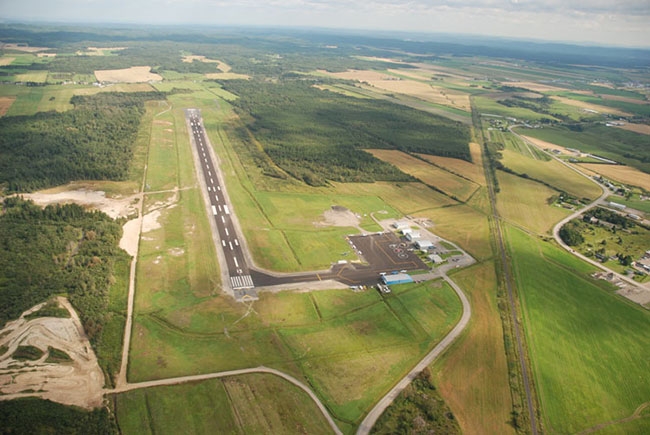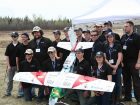
News
Quebec Centre for Innovation in UAV Research
October 17, 2018 By Carroll McCormick
The approval of Beyond Visual Line of Sight (BVLOS) flying and Standard Operating Procedures (SOPs) are major milestones in becoming an international go-to facility for unmanned aerial vehicles (UAV) research and development and operator training in Alma, about 230 kilometres north of Quebec City.
 The UAS CE has access to over 120 The approval of Beyond Visual Line of Sight (BVLOS) flying
The UAS CE has access to over 120 The approval of Beyond Visual Line of Sight (BVLOS) flyingAlma conceived of the UAV test facility, named the Unmanned Aerial System Centre of Excellence (UAS CE), in 2011 as an economic project and registered it with Quebec’s Registraire des entreprises in June 2011. Located on the town’s airport, it has access to its 5,000-foot runway and services such as de-icing, snow removal, fuel and office space.
Infrastructure specific to the UAS CE includes a building built in 2013 with an 8,400-square-foot hangar and over 6,000 square feet of office space. Support equipment includes a mobile ground control station, vehicles, 3G internet access and a generator. UAS CE also built eight special flight zones – restricted airspace, or CYRs for short – extending from the surface to various heights, including one to 18,000 feet. The key feature of CYRs is that they can be closed to non-authorized planes for specific blocks of time, creating safe zones for unconventional aircraft activity.
The UAS CE also has access to CYR airspace belonging to nearby Canadian Forces Base Bagotville. “What we have is access to over 125,000 square kilometres, ranging up to 30,000 feet – about one-fifth the size of France,” says Marc Moffatt, director general of UAS CE.
While there remain infrastructure projects poised to leap off the drawing board, the successes to date of the UAS CE are very much of note. For example, the BVLOS approval is important for any UAV operator, since simply flying around the corner of a building turns a Line of Sight flight into a BVLOS flight, which Transport Canada tightly regulates. “I find that operators are focused on Line of Sight operations. I tell them that they need to get organized, from a Transport Canada point of view, and get ready for BVLOS,” Moffatt says.
Completing the SOPs was also a big coup, considering the UAS CE started with a blank sheet of paper. “I have a letter from NAV Canada and the Department of National Defence accepting our SOPs, and that Transport Canada has approved them. Transport Canada gave us a letter that lets us activate [our] CYRs through these SOPs. This is the final approval so UAS can manage these airspaces,” Moffatt says.
Looking back at the past few years, Moffatt says, “We couldn’t build the UAS without consulting Transport Canada, NAV Canada, and the Department of National Defence. We briefed them, then we shopped around to see if there was an interest in building the UAS. We talked to universities, for example. When we saw that we had interest in it, we registered and built it.”
And interest there is. Just this May, for example, the Texas Lone Star UAS Center of Excellence and Innovation and the Texas A&M Engineering Extension Service penned an agreement with the UAS CE to work together to integrate unmanned aircraft and aerial systems into North American airspace. Other companies and organizations, such as General Atomics, Aero Montreal, SparksDrone and Drone Helix are also working with UAS CE. Other players include Arctic UAV Inc., which conducted a mission there this summer, and a company from Spain that wants to do 500 hours of circuits, beginning this fall.
The UAS CE is also making its new presence felt internationally. In February 2014, for example, it, in collaboration with the UAV test and service centre in Bordeaux, France; the Oklahoma State University Multispectral Laboratories in Ponca City; and the National Aeronautical Centre in Wales, UK, created the International Consortium of Aeronautical Test Sites (ICATS). Said by UAS CE to be the first international organization of its kind, ICATS’ mandate is to enable the development, testing and certification of UAVs. ICATS currently has 11 members.
Involvement in military research has been another goal. The 80-by-100-foot hangar was intentionally sized to hold two Predator UAVs. “We needed to be sure that the Predators could fit into it. That was our target. We are working to follow the military procurement process,” Moffatt says. The UAS CE was built in anticipation of the procurement and testing of UAVs at CFB Bagotville, and handling military as well as civilian contracts.
“If we were to have any hope in getting the United States involved, we had to meet their access regulations. So the areas of the building are card-controlled. We can restrict a visitor to just the administration area or allow access to the hangar too,” Moffatt explains.

